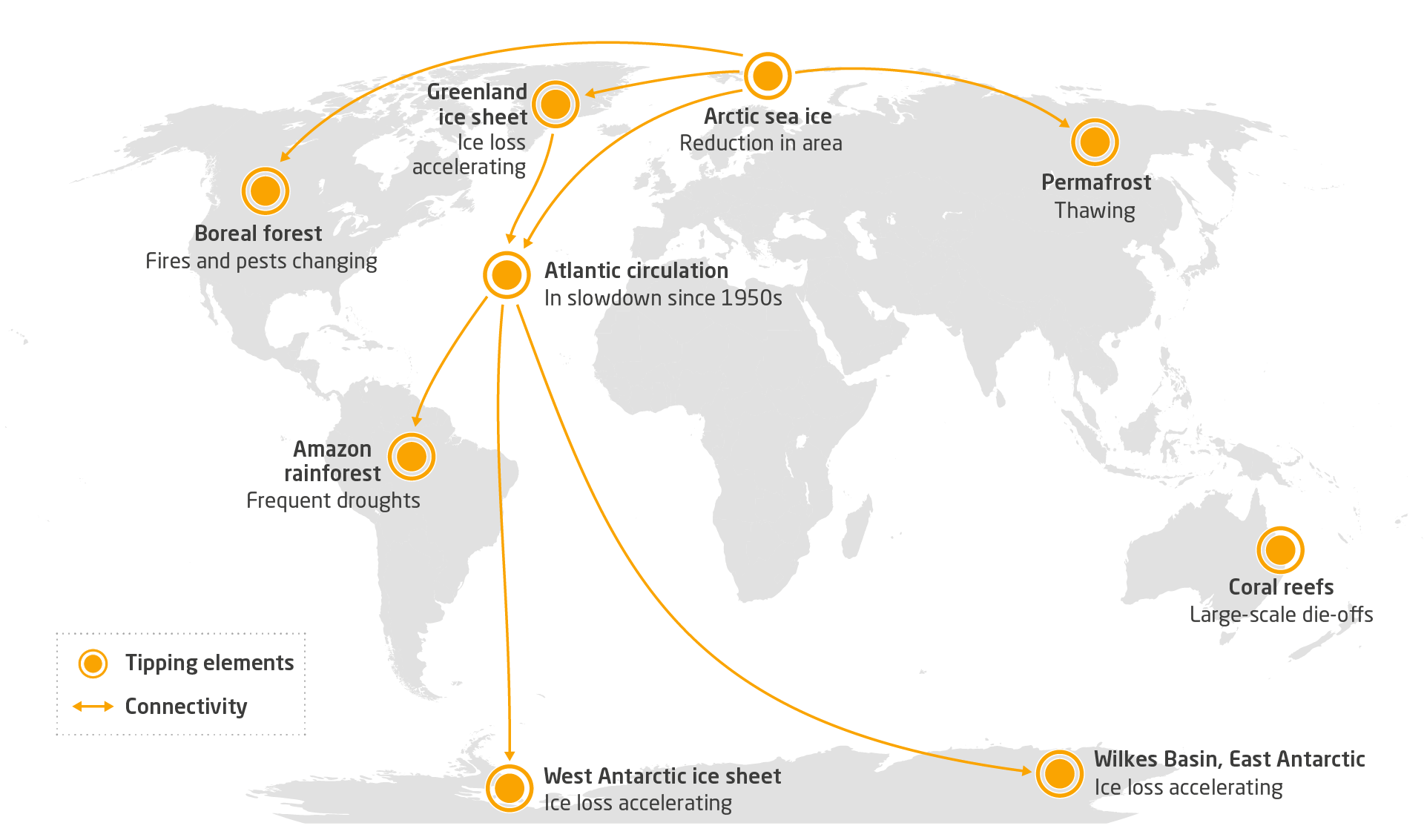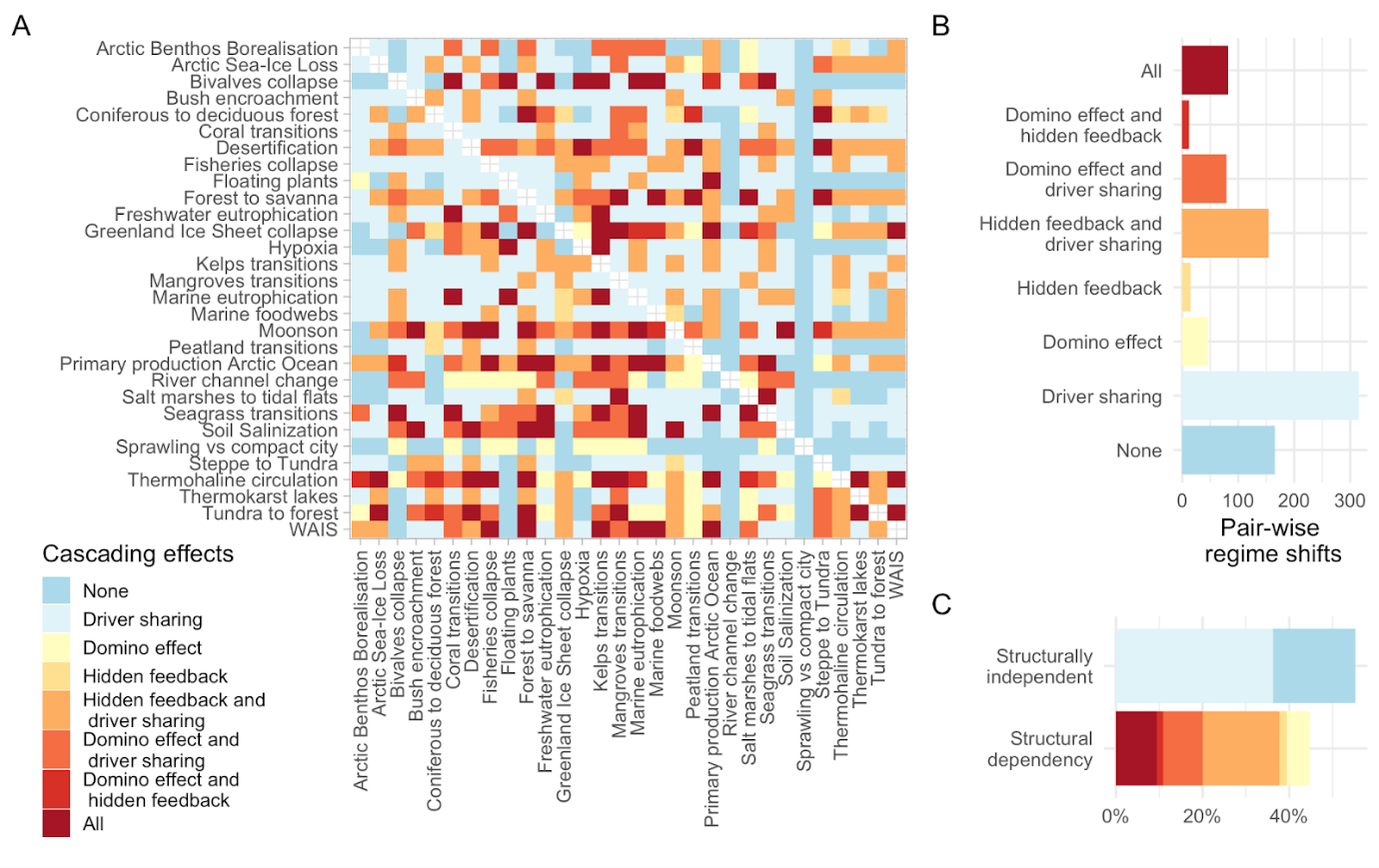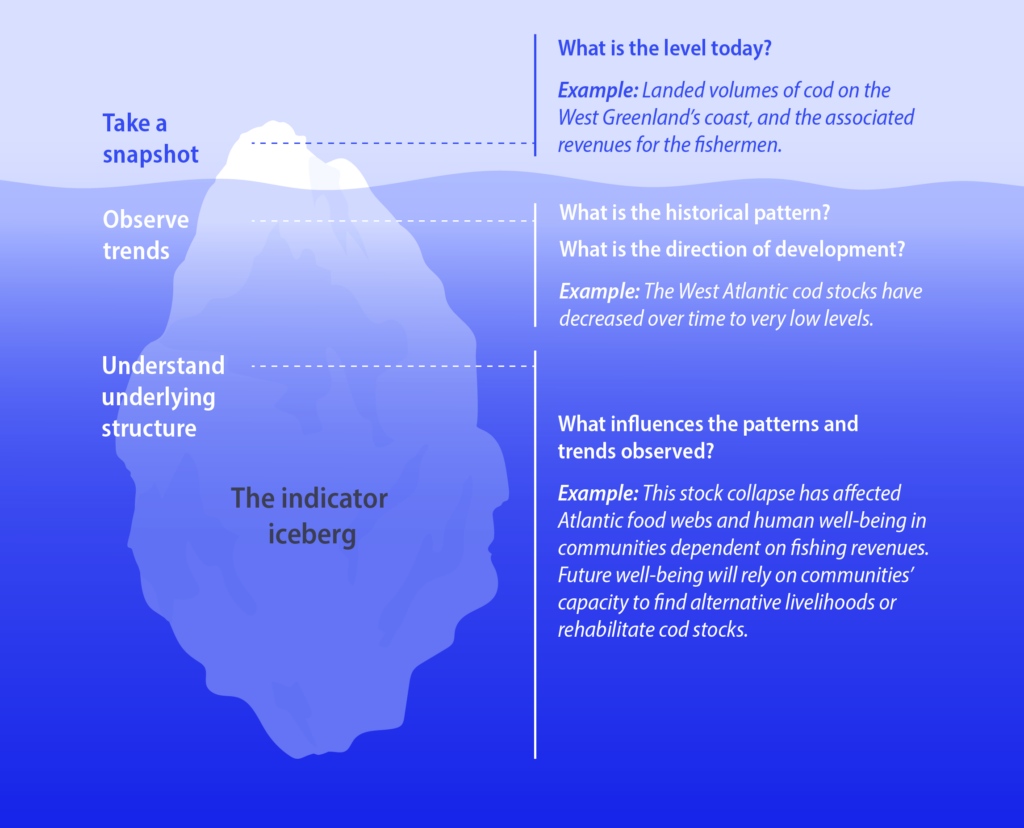Chapter 4
Why Cascading Shifts matter for investors
Juan C. Rocha
The latest report from the International Panel for Climate Change brought the attention of scholars and policy makers to the impending risk of tipping points (IPCC, 2021). Simply put, tipping points are points on a critical parameter, such as temperature, that, once reached, cause a system to flip from one configuration to another. These points are really hard to measure and predict. Nevertheless, we know they exist, and the scientific community has for decades been assessing their risks and uncertainties.
Writing in Science, David Armstrong McCay and colleagues, reported an update on climate tipping points and their risk in 2022 (Armstrong-McKay et al., 2022). They find, for example, that the Amazon rainforest can tip at a 3-4°C increase in average temperatures (see Chapter 5). According to climate models such levels of temperature are reachable in the 2100 century. But recent observations have shown that trees are already reaching such a threshold (at the forest canopy, see Doughty et al., 2023). The Amazon tipping means the forest will no longer be able to play an important role in regulating the climate by capturing and maintaining rich storage of carbon. Instead, it can become a less productive forest or a savanna with detrimental consequences to the species living there today.
It is a concerning fact because the Amazon plays important ecological roles in regulating climate by capturing carbon, as well as acting as a water pump for regions adjacent to the Amazon (Smith et al., 2023; see Chapters 5 and 6). The rainforest creates precipitation that in turn nurtures agricultural landscapes of Latin America and provides water to major urban centers such as Sao Paulo. On the ground, measurements today already show that regions of the Amazon are shifting from being a carbon sink to a carbon source (Gatti et al., 2021).
Thus far scientists have been studying tipping points as independent phenomena. But interactions among tipping points (say, between temperature and precipitation) can exacerbate impacts on human societies. There are two broad classes of interactions. First, interactions of different driving forces on the same system. In the case of the Amazon, consider the many different ways human activities can tip it: by increasing temperature, through human-made fires, or through deforestation. What would happen if we “push” the Amazon on the three drivers at the same time? Scholars believe that the tipping point for deforestation is ~40% with a lower bound of 25% (Nobre et.al., 2016). Today we are at 20%, meaning that we are likely to reach deforestation tipping points well before the temperature one.
The diversity of drivers presents challenges and opportunities for managing systems with tipping points (Rocha et al., 2015a). On the one hand, understanding common sets of drivers opens the opportunity to manage multiple ecosystems under similar threats. For example, in managing agricultural activities by reducing the use of fertilizers, fishing, and sewage can prevent multiple regime shifts in coastal systems (Rocha et al., 2015b). In fact, recent studies have shown that many of these drivers occur at local to regional scales of management, so people on the ground can do a great deal already to avoid ecological collapses. Climate change, although important, is not the only threat. By reducing pollution, and addressing urbanization or food production related drivers (e.g. fishing, agriculture, use of fertilizers), many tipping points can be avoided, or at least delayed.
The second type of interaction is known as cascading effects (Rocha et al., 2018). Imagine a system, like a forest, tips in one part of the world. How does it affect the risk that other ecosystems tip? If the Amazon tips, are other ecosystems at risk as, for example, commodity producers look for other areas to expand agricultural production? Or the other way around, what ecosystems, if tipped, would increase the risk of the Amazon tipping as well?
The scientific community in general agrees that such cascading effects are plausible. However, most of the studies have been modelling work with a focus on the climate system, thus only focusing on tipping elements that are affected by increases in temperature. Tim Lenton and collaborators suggest that climate tipping elements are interconnected (Lenton et al., 2021), and subsequent modelling work has clarified the mechanisms through which systems such as the Greenland Ice Sheet, the Atlantic Meridional Ocean Circulation (AMOC), the Arctic sea ice or West Antarctica, can be connected (Wonderling et al., 2021).
However, this body of work ignores the living fabric of the planet: the biosphere. Biodiversity in these studies is often seen as a storage of carbon, but less is understood about its role in regulating nutrient cycles, the water cycle, or in producing the benefits people get from nature. Local to regional shifts in ecosystems might not be strong enough to cause detectable effects on the climate system. For example, shifts in coral reefs affect the habitat for a diverse set of species, undermine recreation opportunities, affect fisheries, and increase food insecurity or lead to coastal erosion. But can changes in coral communities impact the climate?
Whether these ecological shifts could amplify or exacerbate climate change is still an open question. Shifts in the frequency of forest fires and forest composition in the boreal forest, could amplify climate change at first, but help capture more carbon in the long term (Mack et al., 2021). Shifts in peatlands and thermokarst lakes can release methane, a strong greenhouse gas that amplifies global warming (Koffi et al 2020). To what extent the biosphere can amplify or dampen climate change is still a key frontier of research.
Our study analyzed 30 different types of abrupt shifts in ecosystems, and found that about 45% of all possible couplings resulted in cascading effects (Rocha et al., 2018). We showed the different mechanisms that exist and could couple ecosystems. While climate change is one, it is not the only one. Yet the empirical evidence to help assess the strength and likelihood of these couplings, is still missing. Focusing only on climate could be misleading, strangely erring on being too optimistic.
Back to our example of the Amazon rainforest, the temperature threshold is expected in climate models to be reached by 2100s, but the deforestation threshold could be reached in a matter of decades. Fires and current droughts can move the time to tipping even earlier. Similarly, coral reefs can tip already at 2°C, but their probability of recovery is strongly influenced by interaction with other drivers such as fishing pressure, water turbidity, ocean acidification, or the presence of herbivorous fish. Some of these drivers can be managed locally to build resilience against climate change.
A pre-emptive approach that manages the diversity of drivers is imperative. For some of the drivers, local and regional authorities can intervene (e.g., to halt deforestation). We cannot risk crossing arms and wait until the large nations of the world commit to significant actions in reducing emissions and dealing with climate. Opportunities for meaningful actions are available here and now.
Figure 2. Potential cascading effects of regime shifts. (A) An example of a regime shift from forest to savanna. Regime shifts are typically modeled as the interaction of fast and slow process that creates discontinuous transitions. (B) Driver sharing has the potential to sync two different regime shifts (blue) but not necessarily make them dependent, while domino effects or hidden feedbacks would couple their dynamics by creating structural dependencies (orange). From (Rocha et al., 2018).
Figure 3. Potential structural dependencies between regime shifts.
(A) The three response variables combined show eight different possibilities in which regime shifts can interact through cascading effects. (B) Driver sharing is the most common type found. (C) Domino effects and hidden feedbacks alone or in combination account for ~45% of all regime shift couplings analyzed, implying structural dependence. From (Rocha et al., 2018).
References
Armstrong-McKay, D.I., Staal, A., Abrams, J.F., Winkelmann, R., Sakschewski, B., Loriani, S., Fetzer, I., Cornell, S.E., Rockström, J., Lenton, T.M. (2022). Exceeding 1.5°C global warming could trigger multiple climate tipping points. Science 377, eabn7950. DOI:10.1126/science.abn7950.
Doughty, C.E., Keany, J.M., Wiebe, B.C., Rey-Sanchez, C., Carter, K.R., Middleby, K.B. Cheesman, A.W., Goulden, M.L., da Rocha, H.R., Miller, S.D., Malhi, Y., Fauset, S., Gloor, E., Slot, M., Oliveras Menor, I., Crous, K.Y., Goldsmith, G.R., Fisher, J.B. (2023). Tropical forests are approaching critical temperature thresholds. Nature 621, 105–111. https://doi-org.ezp.sub.su.se/10.1038/s41586-023-06391-z
Gatti, L.V., Basso, L.S., Miller, J.B., Gloor, M., Gatti Domingues, L., Cassol, H.L.G., Tejada, G., Aragao, L.E.O.C., Nobre, C., Peters, W., Marani, L., Arai, E., Sanches, A.H., Correa, S.M., Anderson, L., Randow, C.V., Correia, C.S.C., Crispim S.P., Neves, R.A.L. (2021). Amazonia as a carbon source linked to deforestation and climate change. Nature 595, 388–393. https://doi-org.ezp.sub.su.se/10.1038/s41586-021-03629-6.
IPCC. (2021). Climate Change 2021: The Physical Science Basis. Contribution of Working Group I to the Sixth Assessment Report of the Intergovernmental Panel on Climate Change [Masson-Delmotte, V., P. Zhai, A. Pirani, S.L. Connors, C. Péan, S. Berger, N. Caud, Y. Chen, L. Goldfarb, M.I. Gomis, M. Huang, K. Leitzell, E. Lonnoy, J.B.R. Matthews, T.K. Maycock, T. Waterfield, O. Yelekçi, R. Yu, and B. Zhou (eds.)]. Cambridge University Press, Cambridge, United Kingdom and New York, NY, USA, 2391 pp. doi:10.1017/9781009157896.
Koffi, E.N., Bergamaschi, P., Alkama, R., Cescatti, A. (2020). An observation-constrained assessment of the climate sensitivity and future trajectories of wetland methane emissions. Sci. Adv. 6, eaay4444. DOI:10.1126/sciadv.aay4444
Lenton, T.M., Rockström, J., Gaffney, O., Rahmstorf, S., Richardson, K., Steffen, W., Schellnhuber, H.J. (2019). Climate tipping points – too risky to bet against. Nature. 575, 592-595. doi: https://doi-org.ezp.sub.su.se/10.1038/d41586-019-03595-0.
Mack, M.C., Walker, X.J., Johnstone, J.F., Alexander, H.D., Melvin, A.M., Jean, M., Miller, S. (2021). Carbon loss from boreal forest wildfires offset by increased dominance of deciduous trees. Science 372, 280-283. DOI:10.1126/science.abf3903.
Nobre, C.A., Sampaio, G., Borma, L.S., Castilla-Rubio, J.C., Silva, J.S., Cardoso, M. (2016). Land-use and climate change risks in the Amazon and the need of a novel sustainable development paradigm. PNAS. 113(39): 10759-10768. https://doi.org/10.1073/pnas.1605516113.
Rocha, J.C., Peterson, G.D., Biggs, R. (2015a). Regime shifts in the Anthropocene: drivers, risks and resilience. PlosOne. DOI: https://doi.org/10.1371/journal.pone.0134639.
Rocha, J.C., Tletyinen, J., Biggs, R., Vlenckner, T., Peterson, G. (2015b). Marine regime shifts: drivers and impacts on ecosystems services. Philosophical Transactions of the Royal Society B. 370:2013027320130273. http://doi.org/10.1098/rstb.2013.0273
Rocha, J.C., Peterson, G.D., Bodin, Ö., Levin, S. (2018). Cascading regime shifts within and across scales.Science362,1379-1383. DOI:10.1126/science.aat7850.
Smith, C., Baker, J.C.A. & Spracklen, D.V. (2023). Tropical deforestation causes large reductions in observed precipitation. Nature 615, 270–275. https://doi-org.ezp.sub.su.se/10.1038/s41586-022-05690-1
Wunderling, N., Donges, J. F., Kurths, J., and Winkelmann, R. (2021). Interacting tipping elements increase risk of climate domino effects under global warming, Earth Syst. Dynam., 12, 601–619, https://doi.org/10.5194/esd-12-601-2021.




